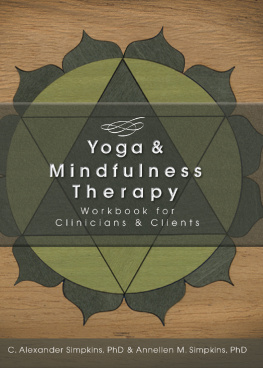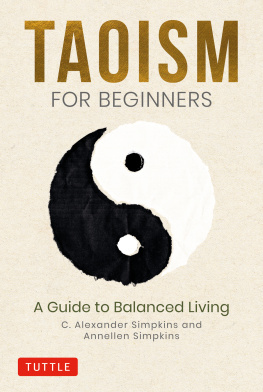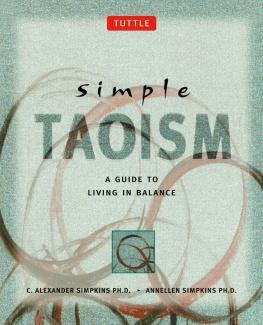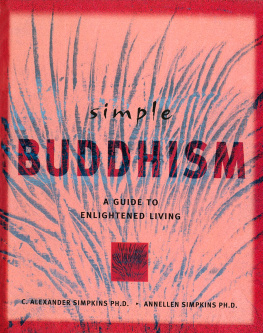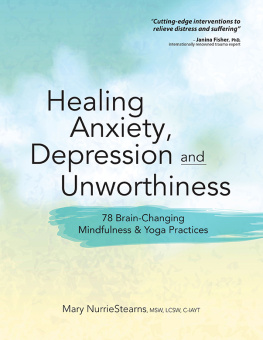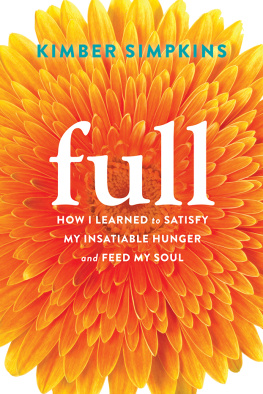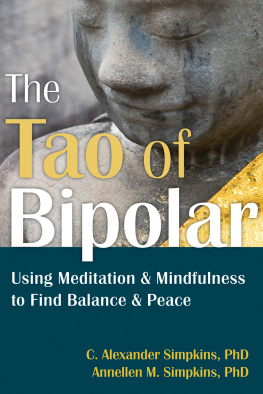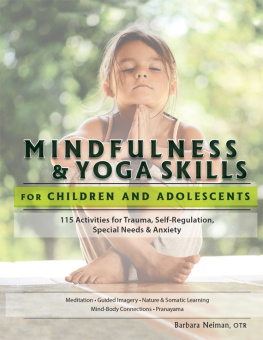E NDORSEMENTS
I recently learned that yoga means unity in Sanskrit. The Simpkins have unified three areas that have rarely, if ever, been pulled together: yoga (not just the body moves, but the deeper psychological, emotional, and spiritual aspects as well), mindfulness practices, and therapeutic methods. Joining them together in a practical way can help relieve stress, anxiety, mood problems, and substance abuse challenges.
You can use these methods for yourself or, if you work with others as a therapist, medical practitioner, or coach, you can use them with clients. [It is] filled with exercises, tips, and inspiring stories.
Bill OHanlon, featured Oprah guest and author of Out of the Blue: Six Non-Medication Ways to Relieve Depression
The Yoga and Mindfulness Therapy Workbook offers a treasure trove of resources and practical exercises that are perfect for anyone wanting a unified mind-body approach to finding greater emotional focus, stability, balance, and ease in life. The timeless truths offered of yoga and mindfulness are seamlessly blended with modern brain science and research to provide solid evidence for why these practices can overcome 21st century stress, anxiety, and depression. The compelling real-life stories throughout the book illustrate that change really is possible! Most importantly, the expertly detailed exercises and many guided illustrations will have you feeling that authors Alex and Annellen Simpkins are right beside you, sharing their years of experience and wisdom, as you step on this path to greater healing and wholeness.
Donald Altman, M.A., LPC, author The Mindfulness Toolbox, One-Minute Mindfulness, and The Mindfulness Code
The Yoga and Mindfulness Therapy Workbook is much more than a workbook. It is also a sourcebook, taking its readers into the philosophical foundations of yoga and mindfulness and forward into their neuroscience and psycho-therapeutic applications. The exercises are user-friendly, and their health benefits are documented and explained. The chapters on yogic breathing, cognitive reframing, and self-regulation of attention are practical and articulate. The Drs. Simpkins have written a magnificent volume that attests to their own authority as well as their decades of clinical practice.
Stanley Krippner, Ph.D., co-author of Personal Mythology and co-editor of Extraordinary Dreams
The Yoga and
Mindfulness Therapy
Workbook
C. A LEX A NDER S IMPKINS , P H D
AND
A NNELLEN M. S IMPKINS , P H D
Copyright 2014 by Alexander Simpkins, PhD and Annellen M. Simpkins, PhD
Published by
PESI Publishing & Media
PESI, Inc
3839 White Ave
Eau Claire, WI 54703
Editing: Bookmasters
Layout: Bookmasters
Cover Design: Amy Rubenzer
Printed in the United States of America
ISBN 978-1-936128-83-9
All rights reserved. No part of this book may be reproduced or transmitted in any form or by any means, electronic or mechanical, including photo copying, recording, or by any information storage and retrieval system without the written permission from the author (except for the inclusion of brief quotations in a review).
Table of Contents
Introduction
We weave the cloth of our everyday
By what we do and give.
The fabric of our everyway
Is made by how we live.
C. Alexander Simpkins
At their heart, yoga and mindfulness hold to the idea that you can cultivate well-being by what you do and how you live. Meditation is a practice, something you do to train the mind and body in ways that bring about a shift in consciousness. Recent research has found that practicing these meditative methods changes your brain and rebalances your nervous system. You experience increased calmness and happiness and can regulate your emotions and behavior, goals that psychotherapy aims to foster. Thus, integrating yoga and mindfulness can facilitate the therapeutic process.
Yoga and mindfulness are practices whereby doing brings knowing; and so, this experiential workbook is intended as something you do, which means we encourage you to actively engage with the material. You will find many different ways to get involved that will evoke a variety of experiences. The chapters contain tips to guide you, information boxes to add more details, lists for easy access, exercises to perform, and illustrations to follow. We also supply journaling guidance and charts to fill out, which will provide feedback as you progress. Case examples show how other people have benefited from using these methods, which serve as inspiration for your own change process. We are excited to bring you this practical workbook!
The learning is offered at two levels. First, you will find that the techniques and methods, with explicit and easy-to-follow instructions, elicit a specific change or a particular response. Then, on a deeper level, nonspecific effects, such as experiencing well-being or changes in your energy level, will occur. Through the process, you will learn how to individualize these methods to suit your personal needs.
W HO C AN U SE T HIS W ORKBOOK ?
This book speaks directly to the reader: clients in therapy, individuals seeking self-help, or therapists who wish to apply these methods with clients or on themselves. Therapists seeking to use yoga and mindfulness with clients can combine the methods we describe with conventional therapies. In some cases, these practices can be used as a stand-alone approach.
W HAT S I NSIDE
Your Yoga and Mindfulness Therapy Workbook is divided into three parts. guides you in developing yoga and mindfulness tools: sensory tools, attention tools, and body tools, all of which facilitate practice.
offers clear instructions in the basic practices of yoga and mindfulness. You will learn how to apply the yamas and niyamas (the dos and donts of yoga), some basic asanas (postures), and practice pranayama (breathing methods). Meditation skills improve as you learn pratyahara (how to withdraw your attention), dharana (keep your focus where you choose), and dhyana (allow the open free flow of awareness). Mindfulness practice teaches you how to have open focus, changing the object of your focus moment by moment. Case examples show how people have used each of these practices for therapeutic change.
With the knowledge and skills you attained in offers separate chapters for each of the following problems: stress, anxiety, depression, trauma, and substance abuse. We recommend yoga and mindfulness protocols, but we encourage you to use exercises from any or all of the chapters. Experiment, feel your response, and let it develop. Be patient and allow the time that change takes. Your mind-brain-body system will shift as healthier habits form and you find balance. Trust yourself and enjoy the process!
The appendix is for therapists. This section explains how to seamlessly integrate yoga and mindfulness into your treatments. You will find answers to questions you may have about how and when to introduce the techniques, ways to adapt your office, and tips for working with clients. And there are special techniques for children and adolescents who do very well with these methods. You will also find a section specifically designed for therapists well-being. As helpers of others, we often neglect ourselves, and this part offers easy-to-use methods for our own personal care and actualization.

